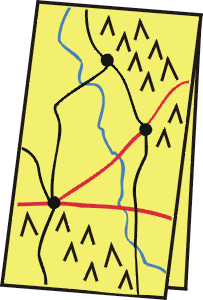|
DIFFICULTIES
WITH EARLY CENSUS SEARCHING
DON'T JUMP TO CONCLUSIONS
The greatest benefit derived from census and tax information is that it provides you with the proper jurisdiction (even down to a local river way, military district, or township in some localities) where other records might be found to prove this is your ancestor.
If pre-1850 census records are not located and studied against later census records, it is very easy to pick up a wrong family line and go down the wrong path in your research.
WATCH OUT FOR CHANGES MADE TO ORIGINAL RECORDS
Early censuses between
1790 and 1840 were copied by hand. The census enumerator
would go door to door and make one original list. He
would then make a copy for the state and often for the
county. Have you ever been tired and left out something
when you were copying it? Have you ever been unable to
read your own handwriting and later had to guess at what
you meant.
What happens when transcriptions are
made of original records?
If you said that
mistakes are often made, you are correct. Some
households were even rearranged into alphabetical order
so the researcher loses the relationship of one person
to another. You see, the census enumerator would go door
to door. People didn�t move into their homes in
alphabetical order. Therefore, the ability of being able
to determine who the neighbors were by seeing the people
listed in the order the census enumerator took the
information is missing.
 There is a way you can
reconstruct the information from an alphabetical listing
if the date is provided for the person being enumerated.
If you put together all the people contacted on the same
date, you may be able to reconstruct the neighborhood.
Then if you look at a map of the area in that same time
period, the locality clues will be apparent. For
example, you might find John Smith who lived near George
Menafee and William Oxblood in the Mill Creek District.
Another John Smith lived in Bear Cub Hollow near Tanner
Alexander and John Almond. Thus from noting the
neighbors, you can determine which family is yours in an
area where there are two families of the same name. Soon
you may be calling them John Smith of Mill Creek and
John Smith of Bear Cub Hollow. There is a way you can
reconstruct the information from an alphabetical listing
if the date is provided for the person being enumerated.
If you put together all the people contacted on the same
date, you may be able to reconstruct the neighborhood.
Then if you look at a map of the area in that same time
period, the locality clues will be apparent. For
example, you might find John Smith who lived near George
Menafee and William Oxblood in the Mill Creek District.
Another John Smith lived in Bear Cub Hollow near Tanner
Alexander and John Almond. Thus from noting the
neighbors, you can determine which family is yours in an
area where there are two families of the same name. Soon
you may be calling them John Smith of Mill Creek and
John Smith of Bear Cub Hollow.
Why do you think you
should look at a map of the time period shown in the census
you are studying? See Figures 1 and 2 in Chapter 1 of Digging Deeper and read their commentaries.
OTHER CENSUS RECORDS
There are other census records which
should be mentioned as they may fill in details and locality clues
from missing population census records. Name two of these alternative
census records as found in Digging Deeper as found on pages 12 and 13.
Answers: (Agricultural, military, ethnic, and manufacturing
schedules.)
|